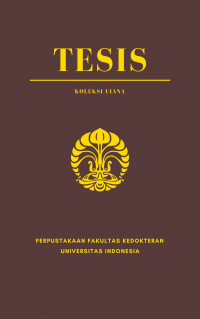Tesis
Efektifitas Terapi Nonoperatif Dibandingkan Dengan Operatif Pada Penatalaksanaan Carpal Tunnel Syndrome Akibat Kerja (Laporan Kasus Berbasis Bukti) = The Effectiveness of Nonoperative Therapy Compared with Operative In the Management of Carpal Tunnel Syndrome Due to Work.
Latar Belakang : Carpal Tunnel Syndrome (CTS) merupakan kelainan neuropati perifer terbanyak pada ekstremitas atas akibat terjebaknya atau terjepitnya saraf medianus pada terowongan karpal. Pada pekerja seringkali diakibatkan oleh gerakan repetitif dengan fleksi dan ekstensi pada daerah pergelangan tangan, gerakan menggenggam erat, getaran. Kasus CTS merupakan gangguan muskuloskeletal pada ekstremitas atas yang mengakibatkan pembiayaan kesehatan yang besar, kurangnya produktivitas, hilangnya hari kerja hingga terjadinya disabilitas. Tujuan : menilai efektivitas terapi nonoperatif bila dibandingkan dengan terapi operatif pada pasien dengan CTS. Metode : Penelusuran artikel dengan menggunakan Pubmed dan Google Scholar dan menggunakan kriteria inklusi dan eksklusi yang telah ditentukan sebelumnya. Hasil pencarian artikel tersebut kemudian dilakukan telaah dengan menggunakan kriteria penilaian validitas, tingkat pentingnya hasil yang didapat pada penelitian tersebut, dan kemamputerapan. Hasil : Studi dalam systematic review ini masih mencakup studi yang sedikit dan sangat heterogen dengan outcomes yang bervariasi sehingga secara clinical efficacy belum dapat diyakini bahwa salah satu intervensi lebih baik yang lainnya pada tatalaksana CTS. Hasil gabungan dari analisis subgrup berupa peningkatan fungsi, peningkatan gejala, peningkatan parameter neurofisiologis, dan biaya perawatan pada waktu tindak lanjut yang berbeda menunjukkan bahwa perbedaan tidak signifikan secara statistik antara kedua intervensi. Perbedaan komplikasi dan efek samping secara statistik signifikan dan pengobatan non operatif mencapai hasil yang lebih baik daripada operatif (OR= 2,03, 95% CI= 1,28-3,22, p= 0,003). Kesimpulan : Tatalaksana pada pasien Carpal Tunnel Syndrome baik dengan intervensi operatif maupun non operatif memiliki keuntungan masing- masing. Hasil intervensi dari segi peningkatan fungsi, perbaikan gejala dan parameter neurofisiologi serta pembiayaan tidak ada ada perbedaan yang signifikan antara keduanya. Intervensi operatif dapat dilakukan apabila perawatan non operatif gagal.
Kata Kunci : Carpal Tunnel Syndrome, operatif, non operatif, gejala, terapi
Background : Carpal Tunnel Syndrome (CTS) is the most common peripheral neuropathy in the upper extremities due to trapping or pinching of the median nerve in the carpal tunnel. In workers it is often caused by repetitive movements with flexion and extension on the wrist area, tight grasping movements, vibration. CTS cases are musculoskeletal disorders of the upper extremities with the most expensive health financing in the United States. In addition, it also causes loss of work days that exceed other occupational diseases other than fractures. CTS also results in large compensation expenditures, lack of productivity to disability. Objective: to assess the effectiveness of nonoperative therapy when compared with operative therapy in patients with CTS. Methods: Searching the articles by using Pubmed and Google Scholar as well as inclution and exclution criteria predetermined, articles were than performed using the assesment criteria of validity, importance, and ability applied Results: The studies in this systematic review still include few and very heterogeneous studies with varying outcomes so that clinical efficacy cannot yet be believed that one of the other interventions is better in the management of CTS. The combined results from the subgroup analysis of improved function, improved symptoms, increased neurophysiological parameters, and treatment costs at different follow up times showed that the difference was not statistically significant between the 2 interventions. The difference in complications and side effects was statistically significant and nonoperative treatment achieved better results than operative (OR= 2.03, 95% CI= 1.28-3.22, p= 0.003). Conclusion: The management of Carpal Tunnel Syndrome patients with both operative and non-operative interventions has their respective advantages. The results of the intervention in terms of improved function, improvement of symptoms and neurophysiological parameters and financing there is no significant difference between the two. Operative intervention can be done if non-operative care fails.
Keywords: Carpal Tunnel Syndrome, surgical, non surgical, therapy, symptoms
- Judul Seri
-
-
- Tahun Terbit
-
2020
- Pengarang
-
Dewi Indah Lestari - Nama Orang
Indah Suci Widyahening - Nama Orang
Astrid B. Sulistomo - Nama Orang - No. Panggil
-
T20001fk
- Penerbit
- Jakarta : Program Pendidikan Dokter Spesialis Kedokteran Okupasi., 2020
- Deskripsi Fisik
-
xii, 28 hal; ill; 21 x 30 cm
- Bahasa
-
Indonesia
- ISBN/ISSN
-
-
- Klasifikasi
-
NONE
- Edisi
-
-
- Subjek
- Info Detail Spesifik
-
-
| T20001fk | T20001fk | Perpustakaan FKUI | Tersedia |


Masuk ke area anggota untuk memberikan review tentang koleksi